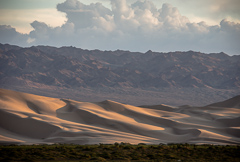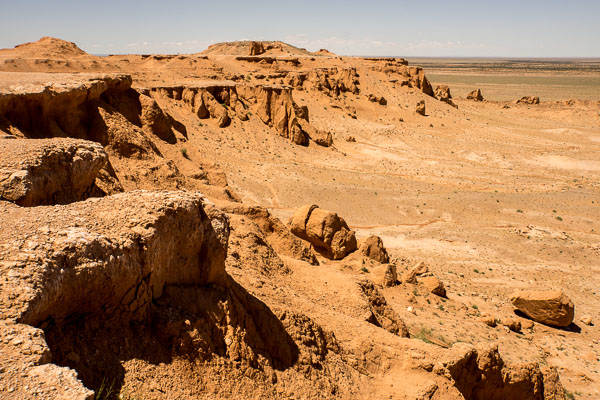The Gov

Deep inside this area, sandwiched between two small ridges, is a strip of sand dunes roughly a kilometer or two wide and a hundred kilometers long, the ones you saw on the cover of National Geographic and which pop from your memory when you hear the words Gobi Desert. The camels live nearby on the grass and shrub. They do not like to climb sand dunes, but will walk on sand, and from just the right angle and with just the right lens the effect is of an endless barren expanse. That impression supports an entire tourist industry that caters to foreigners like us, who want to get the essence of Mongolia but don't have, say, a year to see it. There is a network of ger camps with restaurants serving westernized Mongolian food, all at convenient intervals to the tourist highlights.
On our whirlwind tour we flew to Dalanzadgad early in the morning and were met by Oyuna, our guide, and a driver in a four wheel drive van. We saw the red eroded soil at Flaming Cliffs, where dinosaurs were first discovered in Mongolia; the famous sand dunes; a canyon which until very recently had ice in it all year long. Between these highlights were mile after mile of dirt roads and nearly flat open space that was only limited by a faintly visible distant mountain ridge. Dotting this landscape like pepper sprinkled from an airplane were an occasional herd of goats, a few horses or camels, and once in a while the dust plume of another vehicle on another dirt path far in the distance.
While I was disappointed that there were not more sand dunes, the ones we found were really amazing. They are so tall and unstable that climbing them is an ordeal. On our way up, Oyuna stopped us to hear the dunes "sing," a groan or moaning sound they make when they countless grains of sand decide to shift. The same sound, induced by our disturbance, could be heard when we were hiking down from the top.
There is one other amazing fact about the Gov, noticeable because of our previous year's experience in other parts of Mongolia. There is no litter, or practically none. It is unlike anywhere else we had been. When I remarked on this to Oyuna, a reserved smile slid across her face, partly not wanting to admit it but also, I think, a little pleased that I noticed. "Not many Mongolians come here," she explained. "The ones who do understand that foreign visitors do not want to see garbage." In a part of the country that depends so heavily on tourism, they have figured out how to preserve the impression of an unspoiled wilderness.
